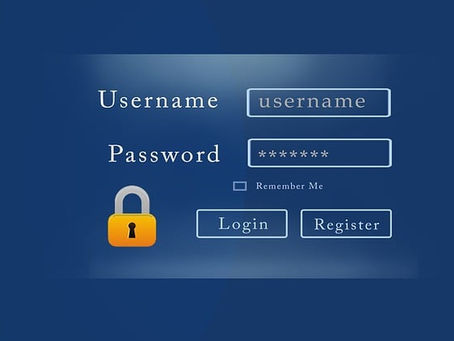All About Secure Authentication
Share

image courtesy pixabay.com
In an era where digital identity is a gateway to personal and organizational data, the importance of robust authentication methods cannot be overstated. Passwords alone are no longer sufficient to safeguard our digital lives. This blog explores the critical role of strong authentication and introduces concepts like Multi-Factor Authentication (MFA) to strengthen your online defenses.
The Password Predicament
The humble password, once the stalwart guardian of our digital accounts, has become the Achilles’ heel of cybersecurity. As technology advances, so do the methods employed by cybercriminals to crack or steal passwords. Common issues with passwords include:
1. Weak Passwords
Many users still opt for easily guessable passwords, such as “123456,” “password,” or “qwerty.” These are a hacker’s delight, as they can be easily cracked using brute force attacks.
2. Password Reuse
Using the same password across multiple accounts is a common practice, but it’s also a significant security risk. If one account is compromised, it can lead to a domino effect, compromising all accounts using the same password.
3. Phishing Attacks
Phishing attacks often involve tricking users into revealing their passwords. Cybercriminals create convincing replicas of legitimate websites or emails to lure victims into entering their login credentials.
4. Data Breaches
Massive data breaches expose millions of passwords, making them available on the dark web for attackers to exploit. Even strong passwords can become vulnerable in such scenarios.
The Case for Strong Authentication
1. Mitigating Password Vulnerabilities
Strong authentication methods are essential for mitigating the vulnerabilities associated with traditional passwords. By implementing multi-factor authentication (MFA), organizations and individuals can add additional layers of security that significantly reduce the risk of unauthorized access.
2. Enhanced Security
Strong authentication enhances security by requiring users to provide multiple forms of verification before granting access. This added layer of protection ensures that even if one authentication factor is compromised, the account remains secure.
3. Regulatory Compliance
In many industries, compliance with data protection regulations necessitates the use of strong authentication methods. Note that failure to do so can result in severe financial and legal consequences.
4. Protecting Sensitive Data
For organizations, strong authentication is vital for protecting sensitive data, intellectual property, and customer information. Data breaches can lead to irreparable damage to an organization’s reputation and finances.
Multi-Factor Authentication (MFA): The Guardian of Strong Authentication
MFA, also known as two-factor authentication (2FA) or multi-step verification, is a robust authentication method that requires users to provide two or more different factors to access their accounts. These factors fall into three categories:
1. Something You Know (Knowledge Factor)
For your knowledge, this is the traditional password or PIN that the user knows. It’s often the first step in the authentication process.
2. Something You Have (Possession Factor)
This factor involves something the user possesses, such as a mobile device, smart card, or security token. It serves as an additional layer of security beyond the password.
3. Something You Are (Inherence Factor)
Inherence factors are biometric characteristics, like fingerprints, facial recognition, or retinal scans. They are unique to each individual and are difficult to replicate.
The Multi-Factor Authentication Process
MFA typically involves a multi-step authentication process. Here’s how it works:
1. User initiates login: The user enters their username and password, which is the “something they know” factor.
2. MFA request: After the initial login, the system requests the additional factor. This can be a one-time code sent to the user’s mobile device, a fingerprint scan, or another method based on the user’s chosen factors.
3. User provides the additional factor: The user enters the one-time code, uses their biometric data, or provides the possession factor as requested.
4. Access granted: If both factors match the user’s credentials, access is granted.
The Benefits of MFA
1. Improved Security
MFA significantly enhances security by requiring at least two separate authentication factors. Even if a password is compromised, the attacker would still need the second factor to gain access.
2. Protection Against Phishing
MFA helps safeguard against phishing attacks because even if a user unknowingly provides their password to a phishing site, the attacker won’t have the second factor required for access.
3. Flexibility
MFA is highly adaptable. Users can choose from a variety of second factors, including SMS codes, mobile apps, hardware tokens, or biometrics, depending on their preference and security requirements.
4. Regulatory Compliance
For many industries, such as healthcare and finance, compliance with regulatory requirements is mandatory. MFA helps organizations meet these standards.
5. Scalability
MFA can be implemented at various levels, from individual accounts to enterprise-wide solutions. It can scale to meet the needs of both individuals and organizations.
Implementing MFA
1. Choose the Right Factors
The first step in implementing MFA is to select the authentication factors that suit your needs and security requirements. Biometric data is highly secure but may not be practical for all users. Possession factors like mobile apps are convenient and secure for most situations.
2. Select an MFA Solution
Numerous MFA solutions are available, ranging from mobile apps to hardware tokens. Ensure to choose a solution that aligns with your requirements and budget.
3. Enroll Users
For organizations, enrolling users in the MFA system is a crucial step. Users need to understand how to set up and use the second factor. This often involves a one-time setup process.
4. Test and Monitor
Regularly test the MFA system to ensure it functions as intended. Monitoring for any unusual or unauthorized access attempts is also essential.
Advanced Authentication: Navigating the Future of Digital Identity Protection
As the digital landscape continues to evolve, the importance of safeguarding our digital identities grows more critical. Strong authentication methods, particularly Multi-Factor Authentication (MFA), have become a cornerstone of digital security. But what lies beyond MFA? What’s next in the domain of advanced authentication? In this exploration, we’ll examine the future of digital identity protection and unveil the latest innovations in authentication methods.
The Limitations of Traditional Authentication
While MFA has significantly improved the security of digital accounts, it’s not without its challenges. Traditional MFA often relies on factors like “something you know” (password) and “something you have” (smartphone or token). However, these factors can still be vulnerable to various threats:
1. Social Engineering
Even with MFA, attackers can manipulate individuals into revealing their credentials and MFA codes. Social engineering techniques, such as pretexting or phishing, remain effective.
2. Account Takeover
Account takeover attacks involve stealing or hijacking a user’s MFA device, rendering the additional factor useless.
3. Inconvenience
While MFA enhances security, it can be perceived as inconvenient for users, potentially leading to lower adoption rates and resistance.
The Future of Advanced Authentication
To address the limitations of traditional authentication methods, innovative solutions are emerging, paving the way for the future of advanced authentication:
1. Passwordless Authentication
Passwordless authentication aims to eliminate the use of traditional passwords altogether. Instead, it relies on possession factors (e.g., smartphones) and biometrics. Users confirm their identity through fingerprint scans, facial recognition, or PINs tied to their biometric data. This approach enhances security and simplifies the authentication process, reducing reliance on easily compromised passwords.
2. Behavioral Biometrics
Behavioral biometrics examine the unique patterns of human behavior, such as typing dynamics, voice recognition, and mouse movement. By analyzing these behaviors, systems can verify the user’s identity, creating a continuous authentication experience. If a user’s behavior deviates from their established pattern, it may trigger security alerts.
3. Continuous Authentication
Continuous authentication involves ongoing monitoring of user behavior and context. It constantly assesses risk factors, such as device location, network, and behavior. When any suspicious activity is detected, the system can trigger additional authentication challenges. This approach bolsters security by reacting to threats in real-time.
4. Device-Based Authentication
Modern devices are equipped with advanced security features. Many smartphones, for instance, incorporate hardware security modules (HSMs) and secure enclaves. These features can be used for authentication, as they can securely store sensitive user data and cryptographic keys, protecting them from malicious actors.
5. Blockchain Authentication
Blockchain technology is increasingly being explored for secure authentication. It offers the advantages of decentralized, tamper-resistant identity verification. Users can maintain control over their identity data and share it securely when needed. Blockchain authentication also holds potential for cross-platform and cross-border identity verification.
Implementing Advanced Authentication
As advanced authentication methods continue to evolve, organizations and individuals should consider how to integrate them effectively:
1. Evaluate Needs
Start by assessing your specific security requirements and the needs of your users. Not all advanced authentication methods will be suitable for every situation.
2. User Education
With new authentication methods come new user behaviors. It’s crucial to educate users on the proper use of these technologies, emphasizing security best practices.
3. Integration and Testing
Integrating advanced authentication methods may require updates to your existing systems. Thorough testing and monitoring are essential to ensure that these methods work seamlessly and securely.
4. Compliance
Consider the regulatory landscape when implementing advanced authentication. Some industries and regions have specific requirements for user identity verification.


